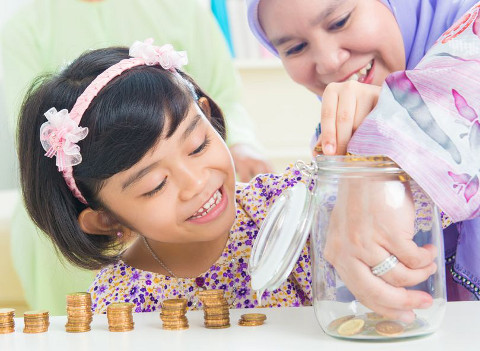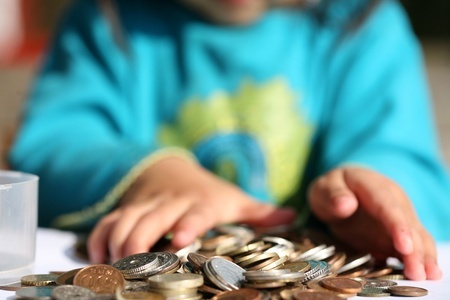Financial responsibility is something that parents can pass on to their kids. Having a clear perspective on personal wealth helps the young ones in self-management and planning ahead. What are some hands-on ways that kids can learn about money? Here are some activities and practices that some parents use out there.
Young kids below 5 years old
1. Coin recognition and the piggy bank

Children learn by observation and repetition. Simple activities include exercises to identify and sort coins and dollars as well as practice putting money into a piggy bank. *(For young children to manage money, they must be past the age of putting things into their mouth).
2. Playing Store and Price matching
To play store, accumulate some empty grocery items and tag them with prices. Give your child a basket and play cashier. For older kids, they can even draw up a shopping list or create promotions for the store items. For the price matching, draw some items on a set of cards with their prices on another set of cards. Mix them up and let your child match them. For example ruler ($0.50), bread ($2.00), fan ($60), computer ($2000).
Kids aged 5 to 9 years old
3. Allowances and savings

The ideal time to start allowances is around the age of 5-6 when kids recognise that money is a mode of exchange. Establish the grounds of the freedom in their allowance. For example, they can only use what is left after they save, they must inform the parents before buying the item they decided on. Some parents up the game by matching the amount saved. For example, if the bicycle they want costs $80, the child can save $40 and the parents can match the same. This ties the short-term savings to some goal. The child will also learn how to handle expectations and learn about choices. If he/she wants to spend $10 on some fancy pencil box, then it will take longer to get that bicycle.
4. Play bank
Teach the concept of banking to your child by playing banker. For example, he/she may keep (deposit) money with you in exchange for a paper record. Thereafter, when a withdrawal is needed, a withdrawal slip with the amount to be taken out has to be given you. Issue a receipt of the remaining sum.
5. Categorising with envelopes
Some parents sort out the child’s allowance into envelopes to help teach the concept of basic budgeting. For example, a $10 weekly allowance can be spread into envelopes for different usages – savings, spending, giving etc.
6. Getting involved in real-life finance choices
The supermarket is a good starting point. Buying groceries can be fun by letting the child choose the item to buy within a sum of money. For example, buying bread, milk and tuna with $10. This simple activity allows room for price comparisons and simple budgeting skills. Or you could join a flea market and ask your child to help out. This will give him good exposure on sales.
7. Giving activity
This may take the form of tithing for some or giving away toys. For example, each time more than 10 toys are accumulated, the child has to choose which one to give away. This may even defer buying a new one, if it is too unbearable to have to give any toy away!
Kids aged 10 to 13 years old
8. Getting involved in family spending
The family can work together on a purchase goal, such as buying a new computer by December. A budgeting and savings plan can be drawn up together. Go over advertisements together or browse shops together. Evaluate deals – weighs pros and cons and compare features that are extra against those that are needed. This helps exercise financial discernment and empowers the child.
9. Introducing banking concepts
If the savings account is still done by “depositing with the parents”, concepts of bank interest may be taught either manually or digitally. The child can record expenditures and savings while the parents can set up an interesting formula on an excel sheet. This is valuable in showing that digital money is exhaustible and can be accrued too. This also sets the ground for a basic understanding of ATM and online banking.
10. Budgeting for the weekend’s meals
Involve the child in budgeting the one or two meals over the weekend. This fun activity lets the child exercise choice and bears responsibility for their decisions.
11. Giving activity
Giving to charity and social causes can help expand the child’s world view even if it is a small amount. This also teaches the concept that not all money has to be used on self.
⇒ Related Read: Where To Donate Your Kids Pre-Loved Toys, Books, Clothes And Home Furniture In Singapore
By Som Yew Ya.
Note: The ages are general and depend on the child’s developmental stage.
* * * * *
Stay in touch! Subscribe to our Telegram here for our latest updates.
Want to be heard 👂 and seen 👀 by over 100,000 parents in Singapore? We can help! Leave your contact here and we’ll be in touch.


























































